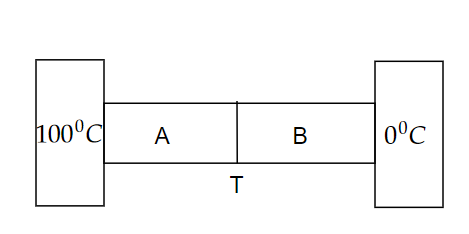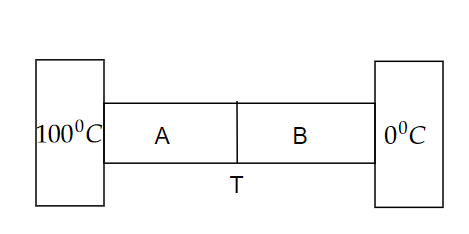
Two metal cubes A and B of the same size are arranged as shown in figure. The extreme ends of the combination are maintained at the indicated temperature. The arrangement is thermally insulated. The coefficients of thermal conductivity of A and B are \[300W/m{/^0}C\] and \[200W/m{/^0}C\] respectively. After a steady state is reached, find the temperature t of the interface.

Answer
218.4k+ views
Hint:In order to solve this problem we need to understand the rate of heat transfer. The rate of flow of heat is the amount of heat that is transferred per unit of time. Here, using the formula for heat flow we are going to find the solution. When the two rods are kept in contact with each other then, the temperature at the junction of 2 rods is known as junction temperature.
Formula Used:
To find the heat flow the formula is,
\[\dfrac{Q}{t} = KA\dfrac{{\Delta T}}{L}\]
Where,
A is cross-sectional area of metal cube
\[\Delta T\] is temperature difference between two ends of the metal cubes
L is length of the metal cube
K is thermal conductivity
Complete step by step solution:

Image: Two metal cubes of the same size.
Consider two metal cubes A and B of the same size. The extreme ends of the combination are maintained at the indicated temperature and are thermally insulated. If the coefficients of thermal conductivity of A and B are \[300W/m{/^0}C\] and \[200W/m{/^0}C\]. After it reaches steady, we need to find the temperature t of the interface. The rate of flow of heat for both metal cubes is,
\[{\left( {\dfrac{Q}{t}} \right)_1} = {K_1}A\dfrac{{\Delta T}}{L}\]
And, \[{\left( {\dfrac{Q}{t}} \right)_2} = {K_2}A\dfrac{{\Delta T}}{L}\]
As we know that, at steady-state,
\[{\left( {\dfrac{Q}{t}} \right)_1} = {\left( {\dfrac{Q}{t}} \right)_2} \\ \]
\[\Rightarrow {K_1}A\dfrac{{\Delta T}}{L} = {K_2}A\dfrac{{\Delta T}}{L} \\ \]
\[\Rightarrow {K_1}A\dfrac{{\left( {{t_1} - t} \right)}}{L} = {K_2}A\dfrac{{\left( {t - {t_2}} \right)}}{L} \\ \]
\[\Rightarrow {K_1}A\left( {{t_1} - t} \right) = {K_2}A\left( {t - {t_2}} \right) \\ \]
\[\Rightarrow {K_1}\left( {{t_1} - t} \right) = {K_2}\left( {t - {t_2}} \right)\]
Given, \[{t_1} = {100^0}C\], \[{t_1} = {0^0}C\], \[{K_1} = 300W/m{/^0}C\] and \[{K_2} = 200W/m{/^0}C\]
Then, above equation will become,
\[300\left( {100 - t} \right) = 200\left( {t - 0} \right) \\ \]
\[\Rightarrow 30000 - 300t = 200t \\ \]
\[\Rightarrow 500t = 30000 \\ \]
\[\Rightarrow t = \dfrac{{30000}}{{500}} \\ \]
\[\therefore t = {60^0}C\]
Therefore, the temperature t of the interface is \[{60^0}\].
Note:Here, we have considered two rods, in such cases, two rods have different thermal conductivities and are maintained at different temperatures. We found the value of temperature of the common junction by using the heat flow formula.
Formula Used:
To find the heat flow the formula is,
\[\dfrac{Q}{t} = KA\dfrac{{\Delta T}}{L}\]
Where,
A is cross-sectional area of metal cube
\[\Delta T\] is temperature difference between two ends of the metal cubes
L is length of the metal cube
K is thermal conductivity
Complete step by step solution:

Image: Two metal cubes of the same size.
Consider two metal cubes A and B of the same size. The extreme ends of the combination are maintained at the indicated temperature and are thermally insulated. If the coefficients of thermal conductivity of A and B are \[300W/m{/^0}C\] and \[200W/m{/^0}C\]. After it reaches steady, we need to find the temperature t of the interface. The rate of flow of heat for both metal cubes is,
\[{\left( {\dfrac{Q}{t}} \right)_1} = {K_1}A\dfrac{{\Delta T}}{L}\]
And, \[{\left( {\dfrac{Q}{t}} \right)_2} = {K_2}A\dfrac{{\Delta T}}{L}\]
As we know that, at steady-state,
\[{\left( {\dfrac{Q}{t}} \right)_1} = {\left( {\dfrac{Q}{t}} \right)_2} \\ \]
\[\Rightarrow {K_1}A\dfrac{{\Delta T}}{L} = {K_2}A\dfrac{{\Delta T}}{L} \\ \]
\[\Rightarrow {K_1}A\dfrac{{\left( {{t_1} - t} \right)}}{L} = {K_2}A\dfrac{{\left( {t - {t_2}} \right)}}{L} \\ \]
\[\Rightarrow {K_1}A\left( {{t_1} - t} \right) = {K_2}A\left( {t - {t_2}} \right) \\ \]
\[\Rightarrow {K_1}\left( {{t_1} - t} \right) = {K_2}\left( {t - {t_2}} \right)\]
Given, \[{t_1} = {100^0}C\], \[{t_1} = {0^0}C\], \[{K_1} = 300W/m{/^0}C\] and \[{K_2} = 200W/m{/^0}C\]
Then, above equation will become,
\[300\left( {100 - t} \right) = 200\left( {t - 0} \right) \\ \]
\[\Rightarrow 30000 - 300t = 200t \\ \]
\[\Rightarrow 500t = 30000 \\ \]
\[\Rightarrow t = \dfrac{{30000}}{{500}} \\ \]
\[\therefore t = {60^0}C\]
Therefore, the temperature t of the interface is \[{60^0}\].
Note:Here, we have considered two rods, in such cases, two rods have different thermal conductivities and are maintained at different temperatures. We found the value of temperature of the common junction by using the heat flow formula.
Recently Updated Pages
Two discs which are rotating about their respective class 11 physics JEE_Main

A ladder rests against a frictionless vertical wall class 11 physics JEE_Main

Two simple pendulums of lengths 1 m and 16 m respectively class 11 physics JEE_Main

The slopes of isothermal and adiabatic curves are related class 11 physics JEE_Main

A trolly falling freely on an inclined plane as shown class 11 physics JEE_Main

The masses M1 and M2M2 M1 are released from rest Using class 11 physics JEE_Main

Trending doubts
JEE Main 2026: Application Form Open, Exam Dates, Syllabus, Eligibility & Question Papers

Derivation of Equation of Trajectory Explained for Students

Hybridisation in Chemistry – Concept, Types & Applications

Understanding the Angle of Deviation in a Prism

Understanding Collisions: Types and Examples for Students

Understanding Atomic Structure for Beginners

Other Pages
JEE Advanced Marks vs Ranks 2025: Understanding Category-wise Qualifying Marks and Previous Year Cut-offs

Units And Measurements Class 11 Physics Chapter 1 CBSE Notes - 2025-26

NCERT Solutions For Class 11 Physics Chapter 8 Mechanical Properties Of Solids

Motion in a Straight Line Class 11 Physics Chapter 2 CBSE Notes - 2025-26

NCERT Solutions for Class 11 Physics Chapter 7 Gravitation 2025-26

How to Convert a Galvanometer into an Ammeter or Voltmeter




